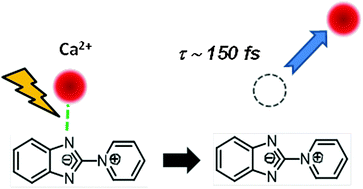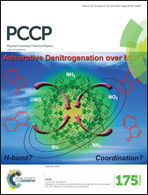Can betaine pyridinium derivatives be used to control the photoejection of cation?†
Abstract
Using a combination of advanced DFT/TDDFT calculations together with ultrafast and stationary spectroscopies we have investigated the photochemistry and cationic complexation ability of 1-pyridinio-benzimidazolate (PyB) and analogs substituted by 15-aza-5-crown (PyB–Aza) or dimethyl-amino groups (PyB–DiMe). Focusing on PyB–Aza, the first aim was to assess the competitive complexation of the imidazole bridge vs. the macrocycle. In acetonitrile, it was found by absorption and emission that the imidazole moiety binds efficiently through lateral electrostatic interaction of high charge density cations and especially Ca2+ to form a 1 : 1, metal : ligand (M : L) complex. Modulation of the complexation toward para substitution of the phenyl ring with a donor group is reported with values ranging from log K = 3.4 to 6.8. Complexation values are properly predicted by DFT calculations. From a photochemical point of view, for the same series, the trend is parallel to the rate of the photo-release process, found to be less than 200 femtosecond (fs), the fastest photorelease characteristic time reported so far. Unlike photoinduced charge transfer molecules linked with an aza-crown group, the mechanism appears simpler with no participation of loose complexes due to the macrocavity effect. Relaxation mechanisms after cation ejection are discussed as well. Finally, even if any photoinduced translocation of cation is reported for the PyB–Aza molecule between two complexation sites, a discussion about the use of betaine pyridinium as a molecular tool for the smart manipulation of cation systems is initiated.


 Please wait while we load your content...
Please wait while we load your content...